Sports are a unifying force in the Philippines, fostering national identity and pride. Basketball and volleyball are two of the most popular sports, captivating fans across the country. For instance, the Philippine Basketball Association (PBA) is one of the oldest and most popular professional leagues in Asia.
The media plays a significant role in promoting sports by amplifying the stories of successful athletes. Manny Pacquiao, a world-renowned boxer, and Hidilyn Diaz, an Olympic gold medalist, are inspirations to many Filipinos. Their achievements are widely covered by local media, motivating future generations to pursue their own sporting dreams.
Grassroots movements and community engagement connect diverse backgrounds through sports. The Palarong Pambansa, a national youth games event, highlights regional talent and promotes unity among young athletes.
Such initiatives stimulate social change by breaking down cultural and socio-economic barriers.
The intersection of sports, media, and community engagement creates a vibrant cultural tapestry that reflects both tradition and modernity.
This dynamic landscape has much to offer, with opportunities for growth, development, and national pride.
Importance of Sports in Filipino Culture
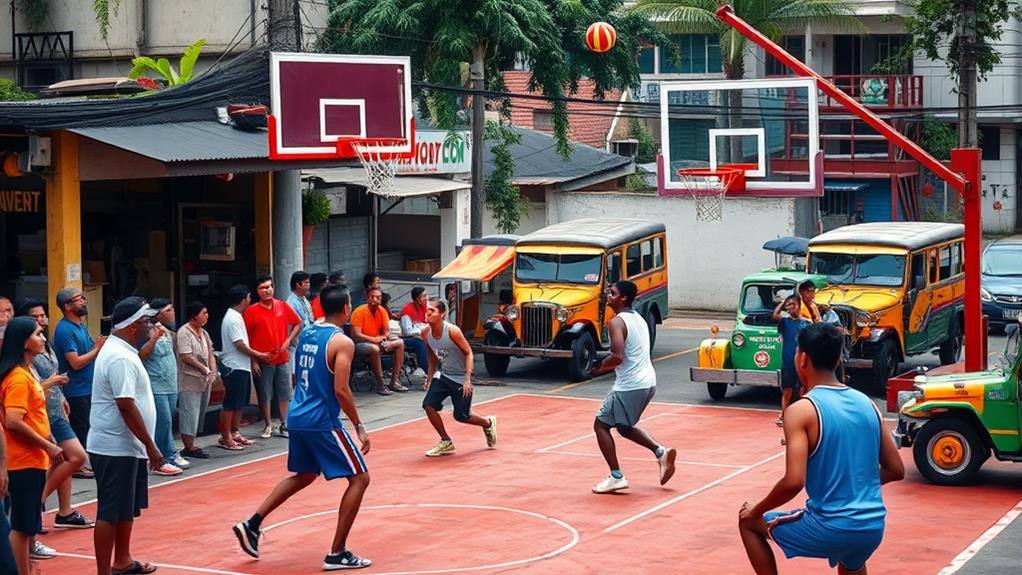
Sports are an integral part of Filipino culture, serving as a unifying force that brings communities together and fosters a sense of national identity.
Basketball is the most popular sport, played in neighborhoods, schools, and communities, creating a shared pastime that unites Filipinos. This communal engagement reflects the essence of Filipino culture, where sports aren't only entertainment but also a means of social interaction and bonding.
Filipino athletes' international successes inspire national pride, as seen in the historic gold medal win in the 2020 Olympics. Such achievements enhance national identity and fuel collective pride, highlighting the significance of sports in national discourse.
Traditional sports like arnis and cockfighting retain cultural significance, showcasing the historical roots of various communities.
Grassroots sports events like the Palarong Pambansa promote local engagement and community pride, encouraging participation and celebrating regional achievements.
The growing popularity of new sports like lawn bowls and petanque demonstrates Filipino adaptability, as they embrace diverse athletic pursuits.
In essence, sports symbolize resilience, unity, and a dynamic cultural landscape that reflects the soul of the Filipino people.
Popular Sports and Activities
Basketball is the most popular sport in the Philippines, captivating fans and players across diverse communities. Its popularity transcends local boundaries, with overseas Filipino workers often forming leagues abroad.
Volleyball has surged in popularity, particularly among women, with amateur and collegiate leagues thriving nationwide.
Traditional sports like arnis and cockfighting are deeply rooted in Filipino culture. These activities not only entertain but also strengthen community ties. Arnis, the national sport, is a martial art that showcases agility and skill, while cockfighting is a centuries-old tradition that brings people together.
New sports are gaining popularity in the Philippines, including lawn bowls and petanque. These emerging activities reflect Filipinos' adaptability to new athletic pursuits. The Philippine Sports Commission and various national sports associations play a pivotal role in promoting these sports, ensuring broad participation and competitive development.
Sports bring Filipinos joy, camaraderie, and identity. As people engage with these athletic pursuits, they become part of a larger narrative that celebrates talent, passion, and the unifying power of sports in popular culture.
Historical Influence on Sports
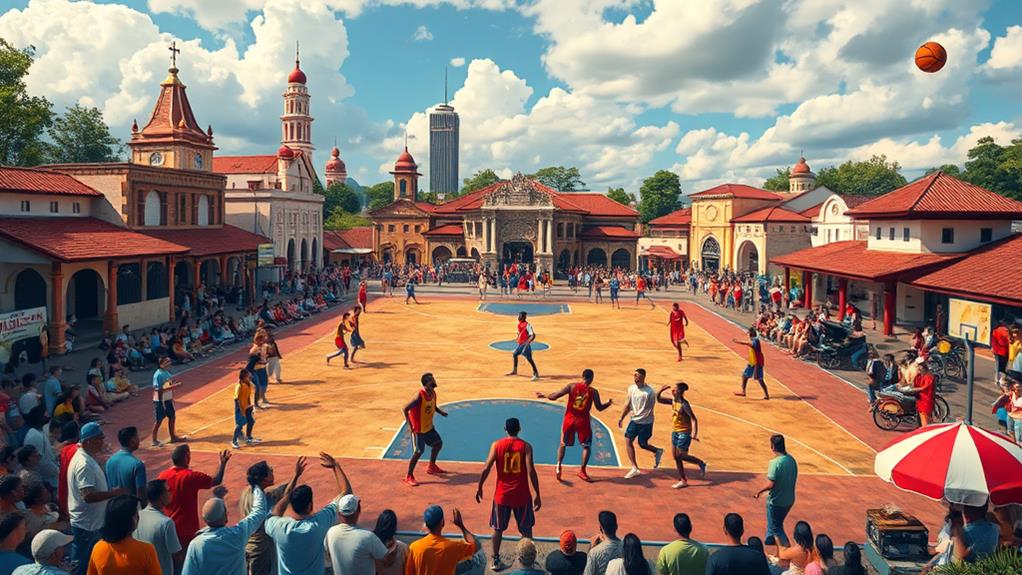
The Philippines' sports landscape is shaped by its rich cultural heritage. The country's sports scene has been influenced by various cultural forces, particularly Western colonizers.
Basketball emerged as a dominant force in the early 20th century due to American cultural influence. This shift highlights how colonial influences shaped the sporting interests of Filipinos.
Cultural exchanges during the Spanish and American periods introduced new sports. Football and volleyball were introduced, broadening the country's athletic repertoire.
Arnis, a traditional Filipino martial art, gained recognition as the national sport in 2009. This blend of indigenous practices with colonial legacies showcases the country's unique sporting identity.
The Philippines' participation in the Summer Olympics since 1924 signifies its engagement with global sports culture.
Boxing and athletics have fostered national pride through achievements in these sports. While modern sports dominate the scene, traditional sports like cockfighting and local games continue to thrive. This emphasizes the nation's rich sporting heritage.
Historical influences on sports in the Philippines reveal a complex relationship between identity, entertainment, and cultural pride. The country's sporting journey is one of adaptation, blending foreign influences with indigenous practices to create a unique sporting culture.
Traditional Sports and Practices
Traditional Sports and Practices in the Philippines
The Philippines is home to a rich array of traditional sports and practices that showcase the country's cultural heritage and community spirit. Arnis, the national sport, is a prime example of Filipino martial arts' historical roots and significance. This sport not only promotes physical skill but also fosters cultural identity, with figures like Supreme Grandmaster Cacoy Caete elevating its global presence.
Cockfighting, or sabong, is a cultural pastime that intertwines gambling with community engagement, drawing crowds and sparking lively discussions, particularly in Cebu. Wrestling and various local martial arts reflect the nation's athletic heritage, linking generations and emphasizing the importance of tradition in modern Filipino life.
Traditional sports play a vital role in Filipino culture, and their significance can be seen in the following ways:
| Traditional Sport | Cultural Significance | Community Impact |
|---|---|---|
| Arnis | National sport, FMA focus | Promotes cultural identity |
| Cockfighting | Gambling, social pastime | Engages local communities |
| Wrestling | Historical roots, tradition | Bonds generations |
| Archery | Heritage sport | Encourages skill-building |
| Horse-riding | Cultural expression | Celebrates local customs |
These traditional sports and practices strengthen communal ties, making them essential to the Filipino cultural landscape.
Competitive Excellence in Athletics
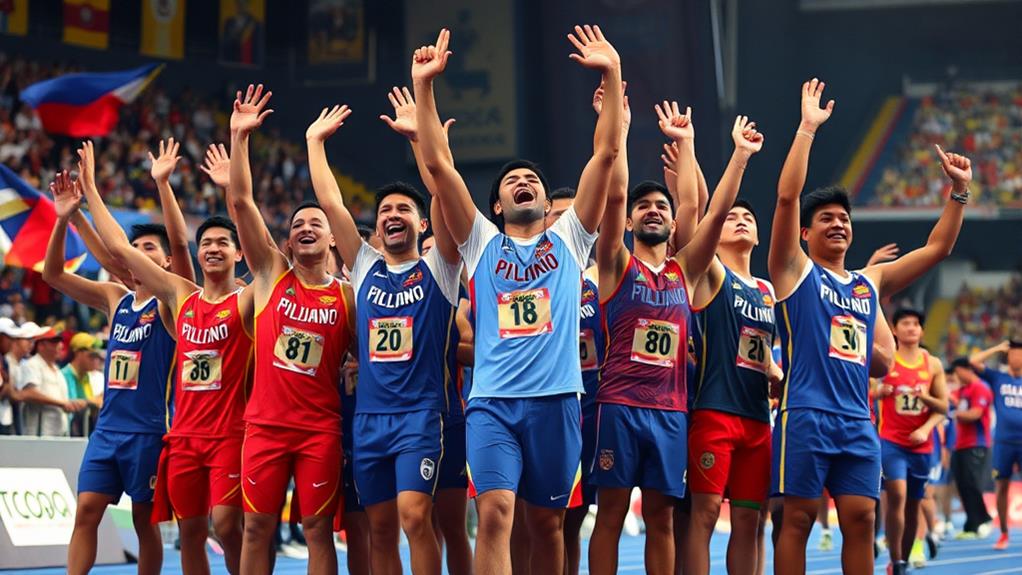
The Philippines has established a strong reputation in athletics globally. Filipino athletes have consistently excelled in various sports, particularly in boxing, where the country has produced over 40 world champions. This impressive track record hasn't only elevated the sport's status locally but also garnered international recognition.
The Philippines made history in the 2020 Olympic Games when weightlifter Hidilyn Diaz won the country's first-ever gold medal, showcasing the nation's competitive spirit.
Additionally, the Philippine Rugby Football Union's rapid rise to the Rugby World Cup in under a decade demonstrates the growing interest and competitiveness in rugby, with the Philippine women's rugby team receiving early invitations to prestigious tournaments.
Cebu has set multiple Guinness World Records in dancesport participation, highlighting the country's commitment to promoting athletic success across various sports.
This blend of competitive excellence not only fuels national pride but also serves as a source of entertainment, weaving sports into the fabric of popular culture.
These achievements demonstrate the dynamic role athletics play in shaping the Filipino identity on the world stage.
Media Representation of Sports
Sports in the Philippines receive widespread media coverage, which significantly influences public perception and fuels a passionate fan culture. Major English-language dailies, such as the Manila Bulletin and Philippine Daily Inquirer, dedicate substantial sections to sports, particularly basketball and boxing. These sports dominate television airtime and attract large audiences, making them cultural phenomena rather than just games.
The Philippine Sports Commission and national sports associations utilize media platforms to promote various disciplines, increasing visibility for athletes and events. Celebrity athletes, like boxing champion Manny Pacquiao, exemplify how media representation can shape public perception. They become role models and brand endorsers, bridging the gap between sports and everyday life.
The portrayal of sports in Filipino pop culture often intertwines with national identity. Major events like the Olympics evoke a profound sense of patriotism and communal pride, amplified through compelling media narratives.
These stories define what it means to be Filipino in today's dynamic society, making sports more than just competitions.
Community Engagement Through Sports
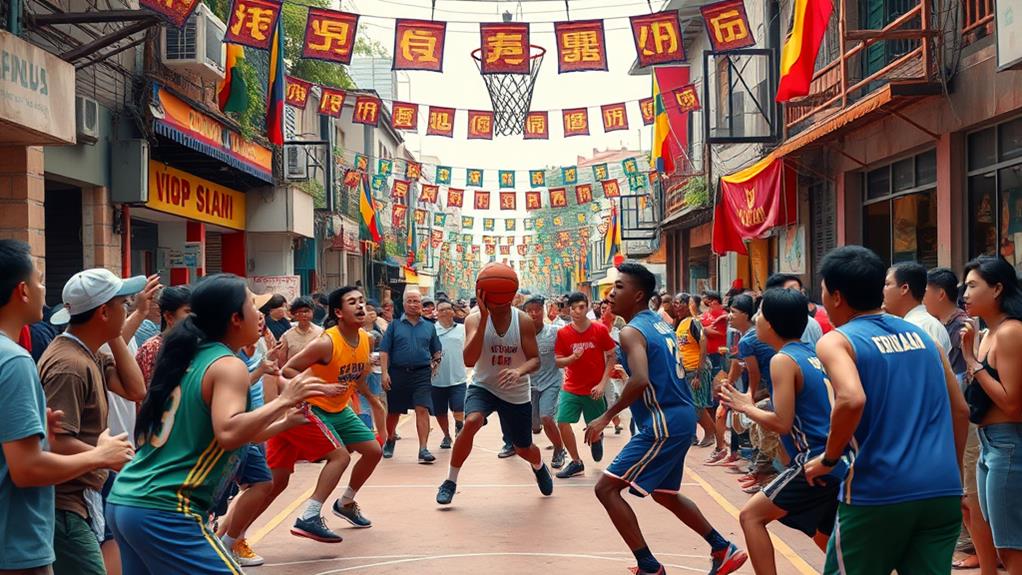
Community Engagement Through Sports in the Philippines
Fostering Unity and Social Connection
Attending local sporting events in the Philippines is more than just watching a game – it's an opportunity to participate in a shared experience that brings people together across different backgrounds.
Local leagues and amateur tournaments encourage participation, reinforcing a sense of belonging and collective identity deeply rooted in Filipino culture.
Regional Talent and Local Pride
Events like the Palarong Pambansa and Philippine National Games amplify community engagement by showcasing regional talent and igniting local pride.
Basketball, in particular, has the power to unite Filipinos and overseas workers through their participation in local leagues, regardless of age or nationality.
The excitement around these competitions enhances community spirit, as everyone rallies together to support their teams.
Sports Rituals and Cultural Connections
Sports rituals, such as tailgating or celebrating victories, are an integral part of Filipino traditions, enriching cultural connections.
These rituals cultivate a shared narrative that strengthens community engagement, promotes inclusivity, and nurtures lasting friendships.
Ultimately, sports become more than just games; they play a significant role in shaping social dynamics and cultural identity in the Philippines.
How Does the Popular Culture Influence Sports Tourism in the Philippines?
The influence of popular culture on sports tourism in philippines is undeniable. The country’s vibrant pop culture, particularly its love for basketball, has attracted sports tourists from around the world. The fusion of music, fashion, and sports has created a unique experience for visitors, making it a top destination for sports tourism in Philippines.
Politics and Sports Intersection
The basketball courts of the Philippines serve as a platform for political expression and social change.
Sports and politics intersect in three key ways:
Media Coverage: Major sporting events often coincide with political milestones, influencing public opinion and reflecting polarized views on governance. For instance, the 2019 Southeast Asian Games in the Philippines took place during a time of political controversy, with many athletes using the event to express their opinions on national issues.
Grassroots Movements: Fans and athletes mobilize together to advocate for social change through community activism.
The "Let's Volleyball for Change" campaign, led by Filipino volleyball players, raised awareness and funds for education and environmental causes. This demonstrates the power of sports to spark civic engagement and promote social change.
Athletes as Advocates: Prominent sports figures use their platforms to address pressing social concerns, inspiring collective action.
Gilas Pilipinas, the Philippine national basketball team, has spoken out against extrajudicial killings and advocated for human rights. By doing so, they challenge the status quo and bring attention to critical issues.
In this dynamic landscape, sports become a vehicle for social commentary, enabling fans and players to voice their concerns and aspirations.
The basketball court isn't just a space for competition; it reflects the pulse of a nation grappling with its identity and governance.
Future of Sports in the Philippines
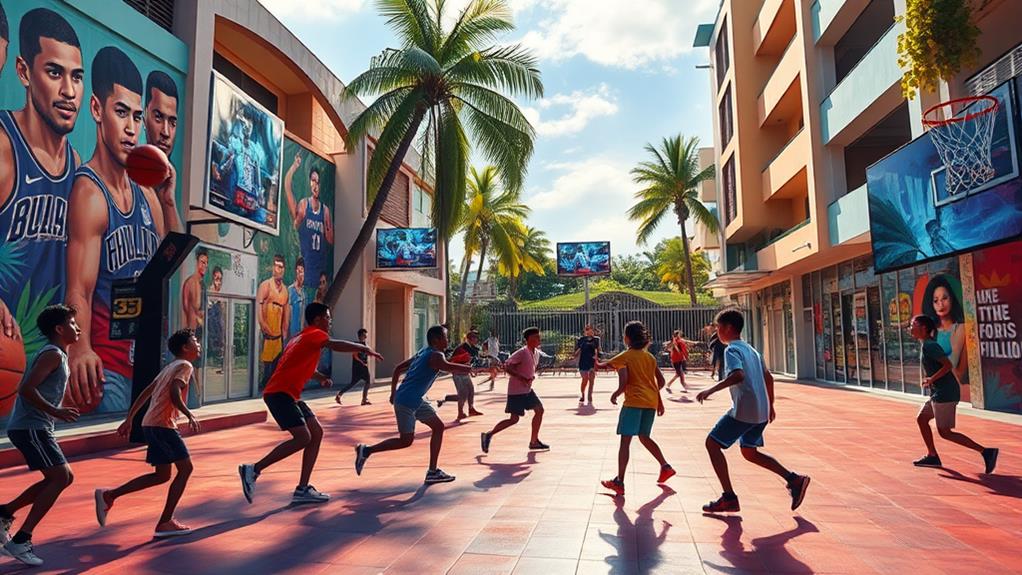
The future of sports in the Philippines looks promising, driven by youth development programs and innovative initiatives.
The Philippine Sports Commission is prioritizing programs that identify and nurture emerging talent across various sports. This focus on youth development enhances the country's competitiveness in international events, inspiring national pride.
The success of athletes like Hidilyn Diaz, who won the Philippines' first Olympic gold medal, motivates grassroots sports participation and inspires young athletes to pursue their dreams.
The growing popularity of sports like rugby and American football promotes inclusivity in Filipino sports culture. Additionally, emerging sports such as petanque and lawn bowls attract a broader audience and participants.
Integrating sports into education fosters active lifestyles among youth. Programs like Palarong Pambansa lay a strong foundation for future sports development.
As these initiatives thrive, a vibrant ecosystem will emerge, where emerging talent and diverse athletic pursuits flourish. The potential for innovation and success is immense, making sports an integral part of the country's cultural identity.
Questions and Answers
What Is the Importance of Sport in the Philippines?
Sports in the Philippines play a crucial role in community building and youth development. They bring people together, promoting unity and cultural identity. For instance, the annual Philippine Basketball Association (PBA) tournament attracts millions of fans, fostering a sense of community and national pride.
Sports programs contribute to social cohesion and gender equality. By providing equal opportunities for participation, they help bridge social gaps and promote inclusivity. The Philippine Sports Commission's "Sports for All" program, for example, offers training and competitions for people with disabilities, ensuring everyone can engage in sports.
The economic impact of sports is significant. Hosting international events like the Southeast Asian Games boosts tourism and creates jobs. In 2019, the Philippines generated over ₱8 billion (approximately $160 million) in revenue from hosting the SEA Games.
International sports representation unites the nation and showcases Filipino talent. When Filipino athletes excel in global competitions, the nation comes together to celebrate their achievements. For example, Hidilyn Diaz's gold medal win in the 2020 Tokyo Olympics inspired a surge of national pride and motivated young Filipinos to take up weightlifting.
How Sports Influence Popular Culture?
Sports shape identities and foster community connections. For instance, sports celebrities like LeBron James and Cristiano Ronaldo become icons, driving trends in athletic fashion and engaging with youth through social media platforms like Instagram and Twitter.
Major sports events spark local rivalries and enhance national pride. The Olympics, World Cup, and Super Bowl are examples of events that bring people together, fostering community spirit and national pride. These events often lead to local rivalries, where fans come together to support their teams.
Sports influence entertainment and social issues. Endorsements and partnerships with athletes raise awareness about social issues, such as equality and education. For example, Colin Kaepernick's partnership with Nike sparked a national conversation about racial inequality.
Sports tourism grows as fans seek experiences. Fans travel to attend major sporting events, visit stadiums, and participate in sports-themed activities. This growth in sports tourism contributes to local economies and promotes cultural exchange.
Sports media amplifies narratives and intertwines athleticism with everyday life and culture. Sports channels like ESPN and Fox Sports broadcast games, analysis, and news, making sports a central part of popular culture.
What Are the Sports in the Philippines Culture?
Sports are an integral part of Filipino culture.
In the Philippines, basketball is a highly popular sport, with local leagues and tournaments being a common sight in many communities. The National Collegiate Athletic Association (NCAA) and the University Athletic Association of the Philippines (UAAP) are two of the most prominent collegiate leagues in the country.
Traditional games also play a significant role in Filipino culture, with sepak takraw, a game that combines elements of volleyball and soccer, being a popular example. These games not only promote physical activity but also serve as a way to celebrate the country's heritage and cultural identity.
Sports icons, such as boxer Manny Pacquiao, inspire and motivate young athletes to strive for excellence. Youth programs and initiatives, such as the Philippine Sports Commission's (PSC) grassroots development program, aim to identify and develop talented young athletes, providing them with the necessary support and resources to succeed.
Local rivalries and community events create a vibrant and energetic atmosphere, with sports competitions often being a central part of these events. The Philippine Basketball Association (PBA), the country's top professional basketball league, is a prime example of this.
The Philippines also participates in international sports competitions, such as the Southeast Asian Games and the Asian Games, which showcase the country's athletic talent and attract sports sponsorships. These sponsorships help to further develop sports programs and infrastructure in the country.
Cultural festivals, such as the Pintaflores Festival and the MassKara Festival, often feature sports competitions and activities, highlighting their importance in Filipino culture and identity. These events bring people together, promoting unity and a sense of community.
What Sport Is Most Popular in the Philippines?
Basketball is the most popular sport in the Philippines. The country's enthusiasm for basketball is evident in the energetic and engaging local tournaments, where communities come together to cheer on their teams.
Although boxing and volleyball have their own followings, basketball's cultural significance in the Philippines remains unparalleled.
The sport has produced notable international players, inspiring young Filipinos to participate and develop their skills. For instance, the Philippine national basketball team has competed in several international competitions, including the FIBA World Cup and the Asian Games.
Additionally, the growth of esports has opened up new opportunities for sports engagement in the Philippines.
However, basketball remains the most unifying and passionate sport in the country, both locally and internationally.